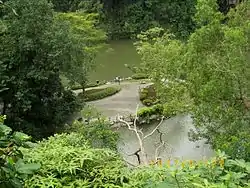Bukit Timah Nature Reserve
The Bukit Timah Nature Reserve is a small 1.64 square kilometre (400 acre) nature reserve near the geographic centre of the city-state of Singapore, located on the slopes of Bukit Timah Hill, Singapore's highest hill standing at a height of 163.63 metres, and parts of the surrounding area. The nature reserve is about 12 kilometres from the Downtown Core, Singapore's central business district.
| Bukit Timah Nature Reserve | |
|---|---|
| Kawasan Simpanan Alam Semulajadi Bukit Timah | |
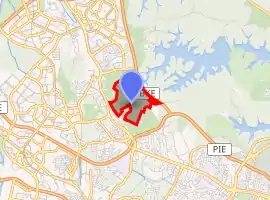
| |
| Type | Nature Reserve |
| Operated by | National Parks Board |
| Status | Open |
| Website | www |
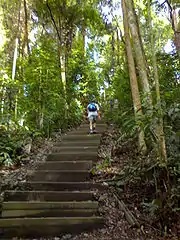
Together with the neighbouring Central Catchment Nature Reserve, it houses over 840 species of flowering plants and over 500 species of fauna.[1] Today, it is one of the largest patches of primary rainforest left in Singapore. The forest reserve was formally declared as an ASEAN Heritage Park on 18 October 2011.[2][3]
Etymology

The name Bukit Timah is borrowed from the tallest hill found in the area of the same name, which is also the tallest geographical location in all of Singapore. Bukit means hill in the Malay language, while Timah means tin . The hill served as a granite quarry for many years, but since the mid-1900s, all operations of which has since been abandoned and converted into recreational areas and even filming locations.
History
In 1882, Nathaniel Cantley, then Superintendent of the Singapore Botanic Gardens, was commissioned by the Government of the Straits Settlements to prepare a report on the forests of the settlements. On Cantley's recommendation, several forest reserves were created on Singapore island over the next few years. Bukit Timah was one of the first forest reserves established in 1883.
All the reserves were worked for timber with the exception of Bukit Timah Reserve.[4] By 1937, the forest reserves were depleted under economic pressures for development. However, three areas, including the Bukit Timah Reserve, were retained for the protection of flora and fauna under the management of the Singapore Botanic Gardens.
In 1951, further protection of the reserves were provided by the enactment of a Nature Reserves Ordinance and the establishment of a Nature Reserves Board for the administration of the reserves, now designated as nature reserves, which total some 28 square kilometres in area.
Today, the nature reserves are set aside for the propagation, protection and preservation of the indigenous flora and fauna of Singapore under the National Parks Act and are managed by the National Parks Board.
Recreation
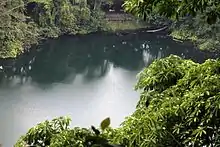
The primary activities at Bukit Timah are strolling, running and hiking. There are also smaller groups of people who rock-climb and abseil at the Dairy Farm quarry as well as mountain biking. There are specially-allocated mountain-bike trails around the area and Bukit Timah Mountain Bike (MTB) Trail [5] is located within the Reserve. The 6.5 km MTB trail loop around Bukit Timah Hill and stretched between Hinhinde Park and Dairy Farm Road. The trail represent a tropical rocky terrain with extended technical climbs and difficult descent at short intervals. For MTB Map trail rating, it is largely made up of black diamond sections with intermittent blue square sections. There are also short alternative double black diamond sections.
The Reserve is popular among athletes training for mountain-climbing. There are a number of hiking trails. The blue trail is rated as "easy" and is 0.7 kilometres (0.43 mi) long, ending overlooking Hindhede Quarry.[6][7] The red trail is also rated as "easy" and is 1.2 kilometres (0.75 mi) long.[6][7] The green trail is rated as "moderate to difficult" and is 1.9 kilometres (1.2 mi) long.[6][7] The yellow trail is rated as "difficult" and is 1.8 kilometres (1.1 mi) long.[6][7] The red, green and yellow trails all end at the hut at the summit of Bukit Timah hill.[7]
Wildlife
Flora
Some of the common plants there are the rattan, figs, and macaranga. Two meninjau trees (Gnetum gnemon) stand near the visitor center.[8] 18 different species of dipterocarps live in the reserve, including the seraya (Shorea curtisii) and Dipterocarpus caudatus.[8] Fan palms (Licuala ferruginea), leaf litter plants (Agrostistachys longifolia) thorny rattan and ferns are also common.[8] Fern species include staghorn fern (Platycerium coronarium) and bird's nest fern (Asplenium nidus).[8] Lichens and fungus, such as bracket fungus are also found.[8]
Fauna
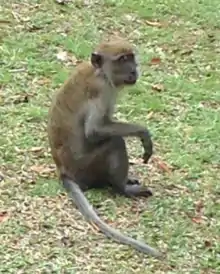
Insects and arachnids
Insects found within the reserve include millipedes, carpenter bees, and many different types of bird, insects and spiders.[8] Common insect species include cicadas and giant forest ants (Camponotus gigas).[8] Common spider species include the golden orb-web spider (Nephila pilipes) and the St Andrew's Cross spider (Arpeggio mangal).[8]
Arthropods
The Singapore freshwater crab (Johora singaporensis) is indigenous to Bukit Timah.[8]
Reptiles
Reptiles in the reserve include the reticulated python (Python reticulatus), the paradise tree snake (Chrysopelea paradisi) and the common sun skink (Eutropis multifasciata).[8]
Mammals
The crab-eating macaque (Macaca fascicularis), a species of monkey, is common in the reserve.[8] The monkeys also enter the area surrounding the park and are common enough that there are concerns that interactions with people will alter their behaviour.[6] Feeding the monkeys is prohibited, and visitors are urged to avoid staring at, baring teeth at or otherwise disturbing or threatening the monkeys.[6][8] Monkeys are not the only mammals in the park. Other mammals include the Malayan pangolin (Manis javanica), Malayan colugo (Galeopterus variegatus), plantain squirrel (Callosciurus notatus) and slender squirrel (Sundasciurus tenuis).[8] The colugos, which are generally nocturnal, can sometimes be seen clinging to trees during the day.[8] Bukit Timah is the only place in Singapore where the red-cheeked flying squirrel (Hylopetes spadiceus) is found.[8]
Raffles' banded langur monkey (Presbytis femoralis) was once found in Bukit Timah but the last individual from the Bukit Timah population died in 1987.[9]
Birds
The greater racket-tailed drongo is one of the most common birds at Bukit Timah (Dicrurus paradiseus).[8] The drongos often follow monkeys through the forest and eat insects that are exposed by the monkeys' actions.[8] Other bird species include the Asian fairy bluebird (Irena puella), the red-crowned barbet (Megalaima rafflesii) and the common emerald dove (Chalcophaps indica).[8] Bukit Timah is one of only two places in Singapore where the red-crowned barbet is found, the other being the Central Catchment Nature Reserve.[8] The reserve, along with the adjacent Central Catchment Nature Reserve, has been identified by BirdLife International as the Central Forest Important Bird Area (IBA) because it supports populations of vulnerable straw-headed bulbuls and brown-chested jungle flycatchers.[10]
Eco-Link
In 2011 the National Parks Board and the Land Transport Authority announced a plan to construct an ecological corridor, the Eco-Link@BKE, at the Bukit Timah Expressway to connect Bukit Timah Nature Reserve with the nearby Central Catchment Nature Reserve.[11] Construction was completed in late 2013.[12] The Eco-Link is an hourglass shaped bridge passing over the expressway, permitting wildlife to pass between the two reserves.[11] Trees and shrubs native to Singapore are planted along the bridge, which provide food for the animals.[12][13] The reserves had been separated since the expressway was built.[11] After monitoring its effectiveness for a few years, the National Parks Board intends to consider opening the bridge to the public for guided walks.[11][14]
Enhancements of Bukit Timah Nature Reserve
For public safety, public access to the Bukit Timah Nature Reserve (BTNR) was limited for about two years from 15 September 2014 as the National Parks Board carried out repair and restoration works to the slopes, trails and forests in the reserve. The National Parks Board also used the opportunity to upgrade its over 20-year-old visitor centre at the foot of BTNR.
The enhancement was completed on 22 October 2015. The visitor centre offers a wealth of information and have interactive exhibits to keep kids engaged.[15] More information on the enhancements can be found on the National Parks Board website.
See also
References
- "Bukit Timah Nature Reserve". National Parks Board. Archived from the original (visitors' guide) on 22 September 2014. Retrieved 19 October 2011.
- "Bukit Timah Nature Reserve declared ASEAN Heritage Park". Channel NewsAsia. 19 October 2011.
- "President endorses ASEAN Heritage Park". AsiaOne. 19 October 2011. Archived from the original on 20 October 2011. Retrieved 19 October 2011.
- "Bukit Timah Nature Reserve" (article). National Parks. Retrieved 23 November 2016.
- "Bukit Timah Nature Reserve". National Parks Board. Retrieved 8 May 2016.
- "Bukit Timah Nature Reserve". Singapore National Parks Board. Archived from the original on 20 October 2013. Retrieved 19 October 2013.
- "Bukhit Timah Nature Reserve Map". Singapore National Parks Board. Archived from the original on 20 October 2013. Retrieved 19 October 2013.
- "A Guide to Bukit Timah Nature Resreve Trail" (PDF). Singapore National Parks Board. Archived from the original (PDF) on 20 October 2013. Retrieved 19 October 2013.
- "Hope remains for last monkeys". Singapore Press Holdings. 8 April 2002. Archived from the original on 29 October 2013. Retrieved 23 October 2013.
- "Central Forest". Important Bird Areas factsheet. BirdLife International. 2014. Archived from the original on 28 November 2001. Retrieved 18 March 2014.
- "Construction Starts for Southeast Asia's First Ecological Corridor. Eco-Link@BKE to Link Two Nature Reserves Across the Expressway". Singapore National Parks Board. 30 July 2011. Archived from the original on 20 October 2013. Retrieved 19 October 2011.
- Poh, I. (5 October 2013). "Start of 'greening' phase of first-of-its-kind $16 million eco-bridge". The Straits Times. Retrieved 25 November 2014.
- "Southeast Asia's First Biological Corridor across the BKE". Land Transport Authority. 15 August 2003. Retrieved 23 October 2013.
- "Eco-Link@BKE: Safe passage for creatures over busy highway". The Straits Times. The Straits Times. Retrieved 14 December 2015.
- C, Caleen. "Up the Hill and Down the Caves at Bukit Timah Nature Reserve". Kids and Parenting. Retrieved 15 December 2016.
External links
| Library resources about Bukit Timah Nature Reserve |
- Bukit Timah Nature Reserve
- Infopedia, Bukit Timah Nature Reserve (National Library Board)
- National Biodiversity Centre, Singapore
